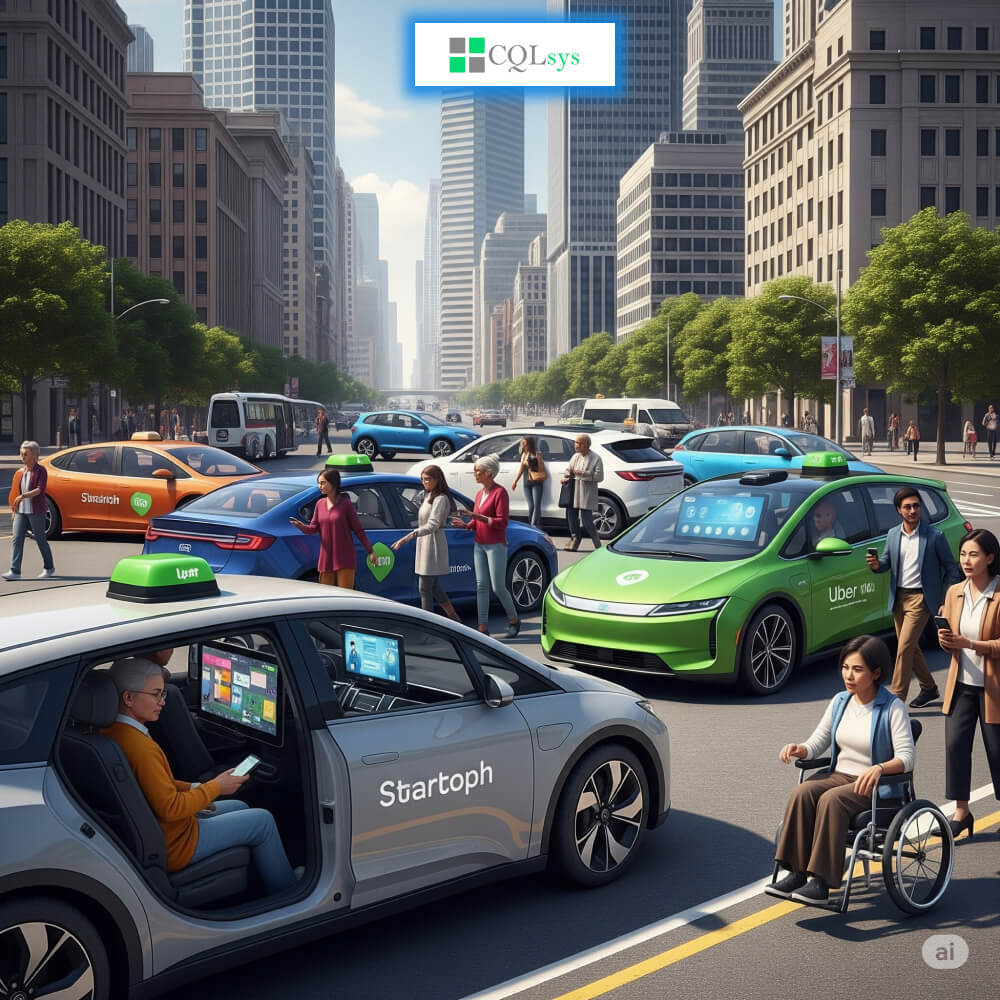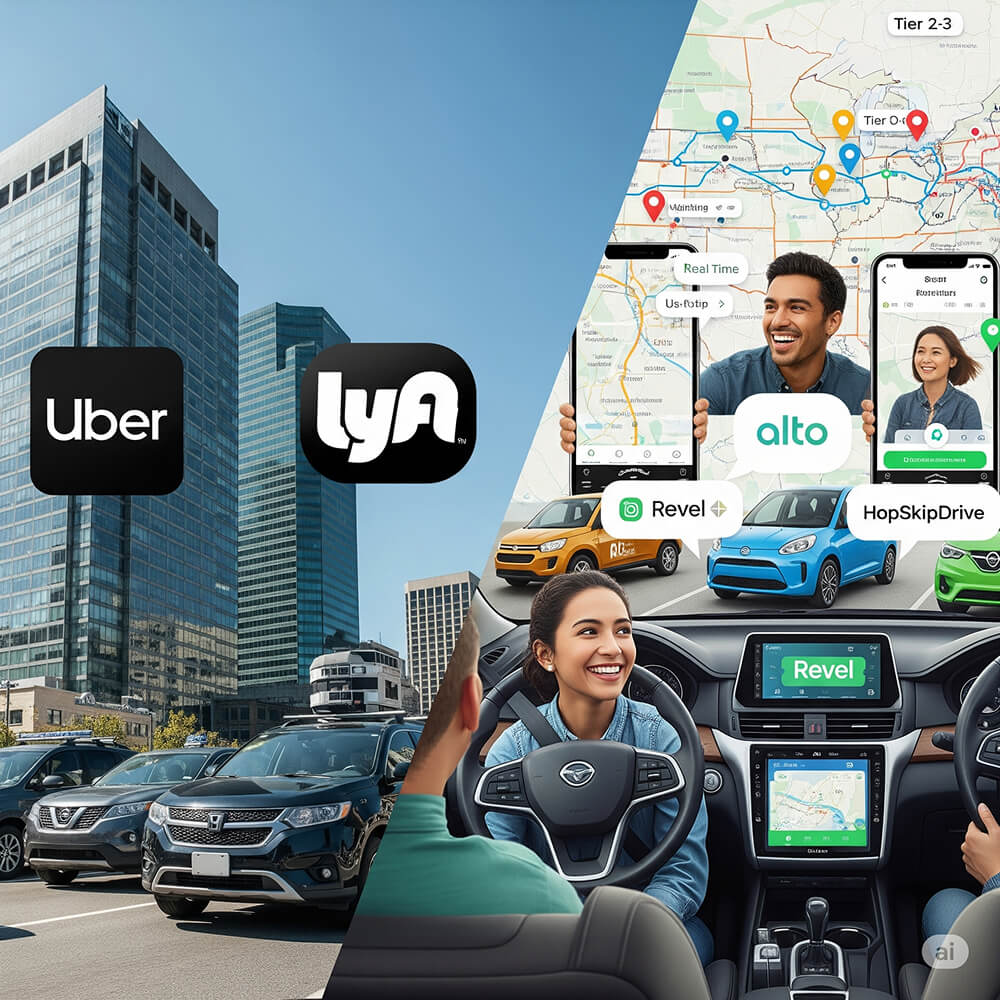How to Compete with Dominant Ride-Hailing Apps in the U.S. Using Smart Tech & Real Examples

Introduction
The U.S. ride-hailing market, a vital part of modern urban transportation, is currently valued at $36.32 billion (2024) and projected to surge to $200.20 billion by 2034. Despite this tremendous opportunity, the space is largely dominated by Uber and Lyft, who control nearly the entire market. For startups and mobility tech innovators, entering this arena may appear overwhelming due to these established giants.
But here’s the truth: this isn’t a zero-sum game. The market is far from saturated—it's segmented. With the right smart mobility solutions for startups and a strategic approach to ride-hailing app development in the USA, new players can compete and thrive. In this blog, we’ll show you how innovative companies are successfully disrupting the status quo by targeting overlooked niches, applying cutting-edge tech, and deploying hyper-localized strategies—supported by real-world ride-sharing app examples that prove the opportunity is real.
Why New Players Still Have a Chance
Despite the considerable footprint of the incumbents, the U.S. market is dynamic and evolving, revealing significant vulnerabilities for agile new entrants:
- Gaps in Service in Smaller U.S. Cities and Suburban Regions: Despite their reach, Uber and Lyft often struggle with service quality and driver availability in Tier 2/3 cities and rural areas. With over 40% of ride-hailing companies expanding into these underserved zones, localized platforms have a prime opportunity to meet rising demand for reliable and affordable transportation.
- User Frustrations with Pricing, Wait Times, or Service Quality: Many riders and drivers are frustrated with major platforms due to surge pricing, long wait times, poor service quality, and unfair pay. A 2022 McKinsey report found that 62% of users value pricing transparency. These issues open the door for alternatives that focus on fairness, clarity, and better user experiences.
- Shift Toward Niche Services: The generic approach of major ride-hailing apps often misses specific user needs. Growing demand exists for niche services like eco-friendly rides, senior transport, women-only options, and accessible vehicles. These specialized markets build strong loyalty, allow higher margins, and face less competition from broad-based platforms.
Major Challenges in the U.S. Ride-Hailing Market

Successfully entering the U.S. ride-hailing arena demands a clear understanding of its unique hurdles:
- Stringent Transportation and Gig Economy Regulations: The U.S. regulatory landscape for ride-hailing is complex and constantly evolving. States and cities impose varied licensing rules, commercial insurance mandates, strict driver background checks (often including fingerprinting), and debated worker classification laws. Navigating this patchwork requires significant legal, financial, and operational resources to stay compliant.
- High Cost of Customer Acquisition and Loyalty: Uber and Lyft have spent billions on marketing and driver incentives, making customer acquisition costly for new entrants. With users loyal to existing platforms, startups face steep expenses—CAC has risen 222% to around $29 per rider, and driver acquisition can cost $400–$600. Competing requires not just pricing, but standout, consistent service.
- Operational Scale Challenges (Insurance, Driver Screening, Compliance): Running a ride-hailing app at scale requires strong systems for driver onboarding, background checks, vehicle maintenance, and insurance. Staying compliant across local, state, and federal laws is an ongoing, resource-heavy challenge.
Smart Tech Solutions for U.S. Ride-Hailing Startups

Technology is no longer just an enabler; it's the core differentiator and the ultimate equalizer for new players in the U.S. mobility startup strategy.
- AI for Route Optimization, Driver Matching, Dynamic Pricing:
- Route Optimization: Leveraging AI algorithms, startups can analyze real-time traffic data, road conditions, and historical patterns to calculate the most efficient routes, minimizing travel time and fuel consumption. This not only significantly improves rider experience by reducing estimated arrival times but also maximizes driver earnings.
- Driver Matching: Advanced AI can precisely match riders with the closest and most suitable drivers based on vehicle type, driver ratings, and even specific rider preferences (e.g., quiet ride mode, specific accessibility needs). This intelligence directly reduces wait times and elevates overall service quality, directly addressing common user pain points.
- Dynamic Pricing: While Uber and Lyft use dynamic pricing, startups can implement more transparent and equitable models. AI can predict demand fluctuations more accurately, allowing for nuanced pricing that precisely balances supply and demand without resorting to the opaque, often frustrating surge fees that alienate users. This is a critical component for building a ride-hailing app in 2025 that prioritizes user trust.
- Real-time GPS Tracking, Vehicle Telemetry, and IoT Integration:
- Real-time Tracking: Precise GPS tracking is fundamental for both rider and driver safety and convenience, offering live monitoring of trip progress, enhancing transparency and peace of mind.
- Vehicle Telemetry: Integrating with a vehicle's onboard diagnostics (OBD-II) via IoT devices provides invaluable data on vehicle health, driving behavior (e.g., speeding, harsh braking), and fuel efficiency. This data is critical for predictive maintenance, targeted driver coaching to improve safety and efficiency, and ensuring a consistently high-quality fleet.
- IoT Integration: Beyond individual vehicles, IoT can connect with smart city infrastructure (e.g., traffic lights, parking sensors) to further optimize routes and identify efficient pick-up/drop-off points, contributing to truly intelligent and efficient smart mobility solutions for startups.
- In-App Wallets, Rewards, and Contactless Payment Options:
- Diverse Payment Options: The U.S. market exhibits diverse payment preferences. Offering a wide array of in-app wallets, seamless integration with popular digital payment methods (Apple Pay, Google Pay, PayPal), and options for corporate accounts simplifies transactions and caters to a broader user base, enhancing convenience.
- Rewards and Loyalty Programs: Implement sophisticated, gamified loyalty programs that genuinely reward frequent riders and high-performing drivers. This could include tiered discounts, free rides, exclusive perks, or expedited service, directly addressing the challenge of high cost of customer acquisition and loyalty by fostering strong retention.
- Multi-State Support for Legal, Tax, and Language Localization:
- Regulatory Framework: The app's backend must be meticulously designed to flexibly accommodate the varying regulatory requirements of different U.S. states and municipalities. This includes specific data reporting mandates, seamless integration with diverse driver background check systems, and localized tax compliance frameworks.
- Language Localization: While English is dominant, genuinely competitive apps support Spanish and other prevalent languages in specific regions (e.g., Mandarin in California, Vietnamese in Texas). Beyond mere translation, this includes cultural nuances in communication and user interface, significantly broadening appeal and improving the user experience (UX).
- Scalable Cloud-Native Infrastructure (AWS, Firebase, etc.):
- Building on robust cloud-native platforms like AWS, Google Cloud, or Microsoft Azure ensures that the app can scale seamlessly and cost-effectively from a small pilot in one city to multiple regions across the U.S. These platforms provide secure, high-performance solutions for real-time data processing, storage, and communication, critical for handling fluctuating demand and rapid expansion.
- White-label Ride-hailing App Platforms to Speed Up MVP Launches:
- For startups with limited resources or tight timelines, speed to market is paramount. White-label ride-hailing software provides a pre-built, customizable foundation, significantly reducing initial development time and cost for an MVP (Minimum Viable Product). This strategic approach allows founders to quickly test their unique value proposition, gather invaluable early feedback, and iterate based on real user data before committing to extensive custom development. This is a powerful accelerator for ride-hailing app development USA.
Real-World U.S.-Based Competitors Challenging Giants

These real-world examples demonstrate that focused innovation and strategic niche targeting can indeed challenge the established order:
- Alto – Safety-Focused, Employee-Driver Ride-Hailing Model:
Operating in major U.S. cities like Dallas, Houston, Los Angeles, Miami, San Francisco, and Washington D.C., Alto offers a unique ride-hailing app model by hiring full-time drivers and owning its fleet of premium, often electric vehicles. This approach ensures high service quality, enhanced rider safety (with features like in-car cameras), and consistent brand standards. By combining a membership-based ride-sharing app with per-ride options, Alto caters to corporate clients and safety-conscious users—demonstrating how custom taxi app development focused on experience can compete with giants.
-
Via – Smart Microtransit with Real-Time Optimization:
Via excels in on-demand transportation app development by powering shared rides through partnerships with transit agencies, cities, universities, and corporations. Its patented algorithms dynamically route vehicles based on real-time demand, optimizing shared trips. This model significantly improves access to transportation in underserved areas, offering a scalable and cost-effective smart mobility solution that complements rather than competes with public infrastructure.
- HopSkipDrive – Specialized Ride-Hailing for Kids & Seniors:
HopSkipDrive fills a vital gap with niche ride-hailing app services for minors and elderly users. Their "CareDrivers" are thoroughly vetted, and the platform offers real-time tracking, layered communication, and strong safety protocols. This model showcases the potential of custom ride-sharing app development for targeted user segments that prioritize trust and security.
- RideCo – White-Label Microtransit Platform for Cities:
RideCo enables U.S. transit agencies to launch and manage their own on-demand mobility apps with real-time routing, paratransit integration, and operational efficiency. Their cloud-based ride-hailing software empowers agencies to deliver flexible, affordable services in low-density areas—proving that white-label ride-hailing platforms can drive innovation in public transportation.
App Development Tips for U.S. Market Entry
Developing a competitive transportation app for local markets in the U.S. requires meticulous strategic planning and execution:
- Localize UX for Regions, Regulations, and Rider Behaviors: The U.S. market is diverse, so localizing your app's UX is crucial. Adapt to regional traffic patterns, cultural norms, payment preferences, and key locations. Ensure built-in compliance with state and city regulations, including tailored onboarding flows and fare rules by location.
- Build Trust: Driver Verification, Customer Support, Real-time Safety Alerts: Trust is the bedrock of any successful ride-hailing service. Implement robust, ongoing driver verification processes that go beyond basic background checks, including recurring motor vehicle record checks and, where mandated, fingerprinting. Provide exceptional 24/7 in-app customer support with easily accessible channels (chat, phone, email). Integrate critical real-time safety features like an SOS button directly connected to emergency services, live trip sharing with trusted contacts, and anonymous in-app feedback mechanisms.
- Integrate App with Municipal Transport APIs, Paratransit Systems, etc.: Look for synergistic opportunities to integrate with existing urban infrastructure. APIs from local transit agencies can provide invaluable real-time data for route optimization, or even enable seamless multimodal transportation options directly within your app, offering a more comprehensive mobility solution. For niche services, direct integration with local paratransit or school transportation systems can provide a significant competitive advantage and a ready-made user base.
- Start Lean: Use Modular Backend and Iterate Based on Early Adopters: Resist the urge to build a feature-rich behemoth from day one. Begin with a lean, modular backend architecture that allows for rapid iteration and scalable feature additions. Launch a Minimum Viable Product (MVP) in a precisely defined, limited geographical area. This strategic approach enables you to gather real-world feedback from early adopters (both riders and drivers) and use data-driven insights to refine your features and strategy before committing to broader expansion.
Go-To-Market Strategy for the U.S.
A well-crafted and precisely executed go-to-market plan is absolutely critical for any on-demand taxi booking platform startup aiming to make a mark in the U.S.:
- Launch in Underserved or Regulation-Friendly States/Cities: Instead of a direct, resource-intensive confrontation with Uber and Lyft in their strongest markets, strategically target smaller cities, sprawling suburban areas, or states known for more favorable and stable ride-hailing regulations. This allows you to establish a strong operational base, gain invaluable experience, and build a loyal user community without the crushing initial competitive pressure.
- Use Promo Codes, Referral Loops, Loyalty Rewards, and Community Events: Aggressive but highly targeted marketing is crucial for initial traction and sustained growth. Implement compelling promo codes for first-time users and robust, double-sided referral programs that incentivize both the referrer and the referred. Build enduring loyalty through tiered rewards systems that offer tangible benefits. Actively engage with local communities through events, sponsorships of local sports teams or charities, and partnerships to build brand awareness and establish trust.
- Partner with Schools, Senior Communities, and Local Businesses: For niche services, direct, strategic partnerships are highly effective for rapid user acquisition. Collaborate with school districts for safe student transportation, senior centers for specialized elderly mobility solutions, or local businesses for exclusive employee commuting programs. These partnerships provide a built-in, pre-qualified user base and can be significantly more cost-effective than broad-stroke advertising campaigns, fostering word-of-mouth growth.
- Optimize App Store and Play Store Listings for Visibility and Conversion: Your app store presence is your primary storefront. Ensure your listings are meticulously optimized with highly relevant keywords (how to compete with Uber and Lyft, ride-sharing app startup examples), compelling screenshots, and clear, benefit-driven descriptions. Actively encourage positive user reviews and respond promptly and professionally to all feedback to improve both your app's visibility in search results and its conversion rate.
Conclusion
The U.S. ride-hailing app development market, dominated by Uber and Lyft, still holds untapped potential for smart mobility startups. This space isn’t saturated—it’s segmented. By identifying gaps and leveraging AI-based ride-matching, scalable cloud infrastructure, and white-label ride-hailing solutions, new apps can launch fast and compete effectively. However, success relies on flawless app development, user-centric UX, and local market strategy. Ambitious entrepreneurs in on-demand transportation have real opportunities to build next-gen taxi booking apps and disrupt the U.S. mobility ecosystem with innovation, purpose, and strategic growth.
